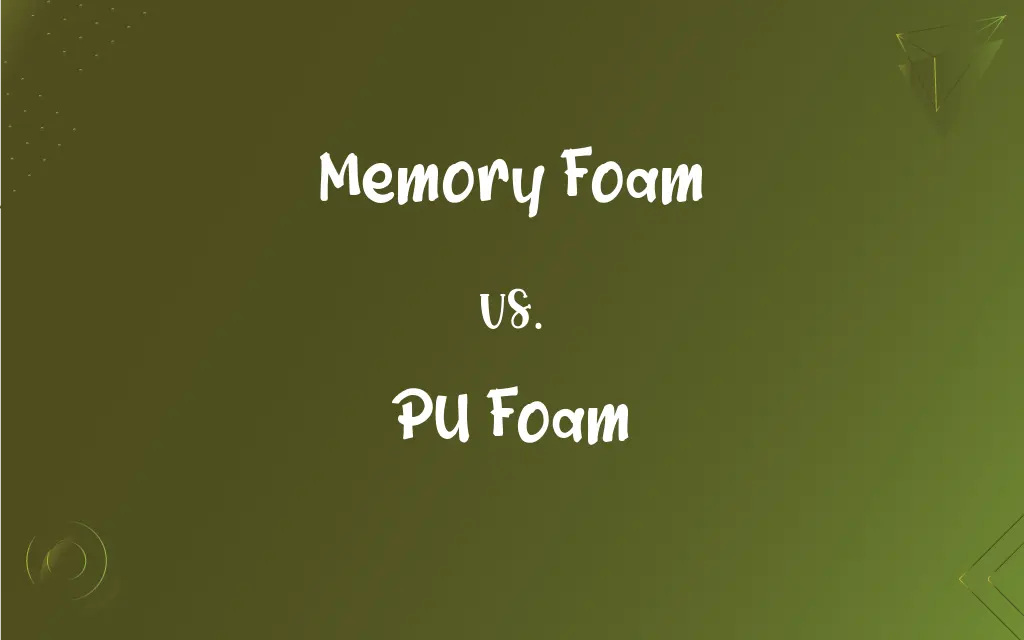Memory Foam vs. PU Foam: What's the Difference?
Edited by Aimie Carlson || By Janet White || Published on February 20, 2024
Memory Foam molds to the body in response to heat and pressure, offering support and comfort, while PU Foam is firmer, providing cushioning and resilience without conforming as closely to body contours.

Key Differences
Memory Foam, also known as viscoelastic foam, is a type of polyurethane foam (PU Foam) with additional chemicals to increase viscosity and density. PU Foam, on the other hand, is a more general category of foam that can vary in density and firmness but lacks the special viscoelastic properties of Memory Foam.
Memory Foam uniquely contours to the body, responding to body heat and pressure to distribute weight evenly. PU Foam, while still cushioning, does not react significantly to heat and maintains a more uniform shape and firmness.
Memory Foam is known for its durability and ability to return to its original shape after compression, making it a long-lasting option. PU Foam may degrade faster, especially in lower densities, leading to less longevity compared to high-quality Memory Foam.
Memory Foam provides superior pressure relief and support by molding to the body's shape, ideal for those with pain or discomfort. PU Foam, though supportive, offers a more generalized cushioning without the tailored support that Memory Foam provides.
Memory Foam is popular in mattresses, pillows, and toppers for its comfort and support properties. PU Foam is widely used in a variety of applications, including furniture cushions, packaging materials, and more, due to its versatility and range of densities.
ADVERTISEMENT
Comparison Chart
Composition
Polyurethane with added chemicals for viscosity.
General polyurethane, varying in density.
Response to Pressure/Heat
Contours to body shape, responding to heat/pressure.
Maintains shape, less responsive to pressure.
Durability
Higher durability, retains shape over time.
Varies, generally less durable than Memory Foam.
Comfort and Support
Superior pressure relief, molds to body.
Provides cushioning, less body-conforming.
Common Uses
Mattresses, pillows, toppers.
Furniture, packaging, general cushioning.
ADVERTISEMENT
Memory Foam and PU Foam Definitions
Memory Foam
A viscoelastic foam that contours to the body for pressure relief.
The Memory Foam mattress adapted to the contours of my body, providing excellent comfort.
PU Foam
A common foam used in everyday products for general cushioning.
The PU Foam in my headphones provides a comfortable, snug fit.
Memory Foam
A durable foam that returns to its original shape after compression.
The Memory Foam seat cushion retained its shape even after prolonged use.
PU Foam
A foam that does not mold to the body as closely as Memory Foam.
The PU Foam mattress was firm and did not sink under my weight.
Memory Foam
Foam that responds to heat and pressure to distribute body weight evenly.
Sleeping on a Memory Foam pillow helped alleviate my neck pain.
PU Foam
A versatile, lightweight foam used in various cushioning applications.
The sofa's cushions are made of PU Foam for durable comfort.
Memory Foam
A high-density foam offering both support and comfort.
My Memory Foam topper added an extra layer of support to my old mattress.
PU Foam
A foam that can vary in density and firmness, suitable for diverse uses.
We used high-density PU Foam for the packaging to protect the fragile items.
Memory Foam
A type of foam used in premium bedding and comfort products.
I chose a Memory Foam mattress for its superior comfort and longevity.
PU Foam
Economical foam option for furniture and packaging.
To cut costs, the manufacturer used PU Foam in the construction of the chairs.
FAQs
What is PU Foam?
PU Foam is a general term for polyurethane foam, used in a variety of cushioning applications.
What is Memory Foam?
Memory Foam is a viscoelastic type of PU Foam that molds to the body in response to heat and pressure.
Which foam is better for a mattress, Memory Foam or PU Foam?
Memory Foam is often preferred for mattresses due to its comfort and support qualities.
Is PU Foam hypoallergenic?
It depends on the specific formulation, but some PU Foams are hypoallergenic.
How does Memory Foam differ in feel from PU Foam?
Memory Foam contours to the body for personalized support, while PU Foam is generally firmer and less conforming.
Can Memory Foam help with pain relief?
Yes, Memory Foam can provide pressure relief and support, often helping with pain relief.
Is PU Foam good for the environment?
Some PU Foams can be less environmentally friendly, but eco-friendly options are available.
Can PU Foam be recycled?
Recycling options vary, but some types of PU Foam can be recycled.
Which is more durable, Memory Foam or PU Foam?
Memory Foam typically has a longer lifespan and better retains its shape over time compared to standard PU Foam.
Are there different types of Memory Foam?
Yes, including traditional, gel-infused, and plant-based Memory Foams.
What are the most common uses of PU Foam?
Furniture, packaging, and automotive applications are common uses for PU Foam.
How does body weight affect Memory Foam's performance?
Memory Foam performs best when matched with an appropriate body weight to ensure proper contouring and support.
What is the best way to clean PU Foam?
Cleaning methods vary, but generally, mild soap and water are used for cleaning PU Foam.
Is Memory Foam more expensive than PU Foam?
Generally, Memory Foam is more expensive due to its specialized properties.
Can PU Foam be used outdoors?
Some PU Foams are suitable for outdoor use, but they must be specifically designed for it.
Does Memory Foam retain heat?
Traditional Memory Foam can retain heat, but newer versions are designed to be cooler.
Can Memory Foam be used in shoes?
Yes, Memory Foam is often used in shoe insoles for added comfort.
Is Memory Foam resistant to dust mites?
Yes, Memory Foam is naturally resistant to dust mites and allergens.
Is PU Foam flammable?
PU Foam is flammable, but many varieties are treated with flame retardants.
How long does Memory Foam last?
High-quality Memory Foam can last up to 10 years or more.
About Author
Written by
Janet WhiteJanet White has been an esteemed writer and blogger for Difference Wiki. Holding a Master's degree in Science and Medical Journalism from the prestigious Boston University, she has consistently demonstrated her expertise and passion for her field. When she's not immersed in her work, Janet relishes her time exercising, delving into a good book, and cherishing moments with friends and family.
Edited by
Aimie CarlsonAimie Carlson, holding a master's degree in English literature, is a fervent English language enthusiast. She lends her writing talents to Difference Wiki, a prominent website that specializes in comparisons, offering readers insightful analyses that both captivate and inform.
































































